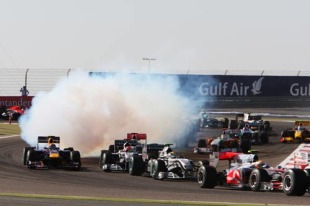
It's a sad but inevitable commentary on Bahrain that some of my newspaper colleagues, having flown direct from Shanghai, are obliged to look for unrest in out-lying villages they would never otherwise visit. The preference, after a hectic race weekend and jumping straight on a plane, would be to check in and chill out with a cool beer. But the pervasive influence of politics dictates otherwise of a sports journalist under orders from his editor.
Despite some disturbing scenes (many of which look familiar to me given my upbringing in Northern Ireland), it appears that the rest of Bahrain, particularly the capital Manama, goes about its business as normal. Which, at this stage, seems the likely outcome for the race itself.
None of this surprises me. The Bahrain Grand Prix has always operated in a curious vacuum completely divorced from the country it represents ever since finding a place on the F1 calendar in 2004. By that I mean, the shining white edifice of the Sakhir track, shimmering like some mirage in the middle of a parched desert, has always made the whole thing seem irrelevant and out of place.
That feeling persists once you come to a halt on the vast Tarmac car park, walk past the familiar Austrian F1 security staff shading themselves from the blazing sun, pass through a very long tunnel and emerge, expecting to see familiar F1 trappings in the paddock.
Except you can't see them. The place is vast and immaculate. It is exactly what the fastidious Bernie Ecclestone has always dreamed of. Because this is a so-called 'flyaway' race, there are no trucks parked side-by-side behind the garages. There is nothing but white, hot concrete stretching to the air-conditioned offices on the far side. You may see the occasional stack of tyres in their blankets but, otherwise, there is nothing to say this is an F1 paddock.
I don't know about you, but I enjoy the hustle and bustle of a paddock, the sound of generators at full chat adding to the sense of impending action and urgency. In Bahrain, you get none of that. And the sense of not knowing where you are is exacerbated by the media centre having no outlook over the track - or anything else, come to that. It's a spacious and well-run facility. But, if it weren't for row upon row of overhead screens showing the same pictures you see at home, you wouldn't know there was anything of note occurring.
It's sanitised to the nth degree. Another part of the Ecclestone dream. No, that's not correct; if Bernie had his way, the irritating media with their probing questions would not be there at all.
I've often felt Mr E feels the same way about spectators cluttering up the place. In Bahrain he partly gets his wish because fans are limited to a couple of grandstands and the imposing structure lining one side of the main straight. There is a buzzy atmosphere here - but nowhere else around the 3.3 miles that make up Sakhir. And believe me, that's a weird feeling.

That's another problem. In the absence of any backdrop or structures, most bends look similar. But it really is a strange feeling to walk the track and see not a single soul; not one piece of infrastructure; no grass (apart from artificial stuff laid within range of the camera); nothing but miles of flat grey dust and fine grit (sand is the last thing you'll find).
Saying all of that, Sakhir has one or two tricky corners, the best being a blind brow leading to a curving downhill approach to a tight left hander at the unimaginatively named Turn 10. Good spot this. Pity is that no one can get to watch it up close.
Viewing for the bulk of spectators is limited to the main grandstand which, in the manner of all Tilke-designed race tracks, echoes like hell as the noise bounces into the solid structure and finds no escape thanks to the massive roof. The good thing, of course, is that this provides necessary protection from the sun beating mercilessly down from dawn to dusk.
Retreating to town for evening refreshment is a tricky business; cold beers are hard to find in this alcohol-free State. There are ways and means, of course, as proved a couple of years ago by a F1 technical chief (who had better remain nameless) crashing off a hotel bar stool while celebrating his birthday. And I don't think the fall from grace had anything to do with a fear of heights.
The offer of a Sheesha with dinner in a restaurant can take your mind off the absence of a glass of wine. The elaborate system of pipes and a gurgling jar involves the drawing of smoke through water but, if you are a non-smoker, the struggle and novelty soon wear off.
You could say that the Sheesha is an appropriate symbol at a time when a lot of smoke is currently being blown in all directions over the business of racing in Bahrain; a place which, politics aside, made you doubt from the outset if it was suitable for a grand prix in the first place.
Maurice Hamilton writes for ESPN F1 in the build-up to each Grand Prix.
© ESPN Sports Media Ltd.
 Maurice Hamilton writes for ESPN F1. A veteran journalist in the paddock, Maurice Hamilton has been part of the Formula One scene since 1977 and was the Observer's motor racing correspondent for 20 years. He has written several books as well as commentating on Formula One for BBC Radio 5 Live
Maurice Hamilton writes for ESPN F1. A veteran journalist in the paddock, Maurice Hamilton has been part of the Formula One scene since 1977 and was the Observer's motor racing correspondent for 20 years. He has written several books as well as commentating on Formula One for BBC Radio 5 Live

